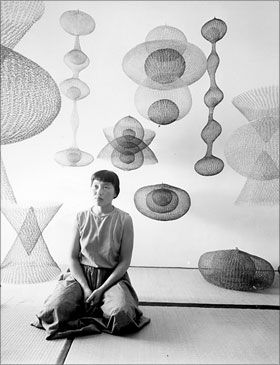

Who could have thought that my inspiration could come from within a tiny interior little office with no windows that is smaller than my bathroom at home? I discovered a hidden competition among the corporate tech community members; those chubby geeks wearing prominent black frames on pallid faces, their garbage can overfilled with waxed wrappers from Quiznos, Dilbert cartoons scotch-taped to their white office doors...haven't you ever seen the movie Office Space?
Hear me out, all of you fashionistas and cooler-than-thou's...
You would think that corporate life stunts creative expression, but amid the mess atop corporate grey metal desktops (chinese stress balls, squishy rubber neon throw things, a plant half-dead 'neath the flourescent lights) I started to see Desk Monsters on people's desks. Not cheesy plastic stuff, not corny "Decision-Maker Dartboards", not Voodoo dolls with the boss' face superglued on the front, but real, REAL SCULPTURE?
One of my clients was on New Year's vacation, and asked me to come sit at his desk a couple days while he was away, to load a database onto the lawfirm's server. "Sure, go have fun." Then I saw his Desk Monster.

He likes classically styled Mexican paper-mache figures. This one I saw on his desk seemed to be a Meso-American god (maybe Mayan? Olmec?), about 10 or 11 inches tall, in brilliant reds, yellows, blues and whites, with lighting bolts crowning the head of a terrible countenance, so cool. I think it might have been Quetzalcoatl, a death god in the ancient Yucatan, he must've gotten it while on vacation.

His friend in the next office had a 3 foot long painted Iguana from South America, this one was made of clay, like this guy over here, brightly colored and hanging down unexpectedly from a corkboard.

In New York, a good friend of mine kept a 6 inch figure of a samurai and his begowned horse, he said it represented his "warrior spirit". (Yes, he's a chubby SQL programmer with 2 kids and wears glasses.) Can you imagine that my friend spent over $100 for his amazingly detailed little statue of an 18th century Japanese nobleman? We talked about it for an hour.
So, I got my own 2 pieces of sculpture for my desk, or maybe I will take them home and put them around the apartment. Both of these pieces are indiginous art from Bali. The artists come from small villages on the beautiful, mysterious tropical islands, where sculpture and wall art and textiles render a gorgeous spectrum of colors and layered designs reflecting the jungle and the sea. The Mermaid, the first piece, below, bears a cross at her neck and wears a sarong adorned with swirling kelp, carved from wood and painted with small tiny dots. The Princely Frog, the second doll, wears handloomed ikat cloth in blue and green, and his head and hands are lacquered wood, tattooed with a primordial jungle.
Maybe you should get a lovely sculpture because it reminds you where you are from. Maybe it's a momento of a great vacation you went on. Maybe it is your avatar. I just found it to be really fun and very unique and personal.
Update: I think I'm going to do a series of design at work....will keep you "Posted". (haha).



































